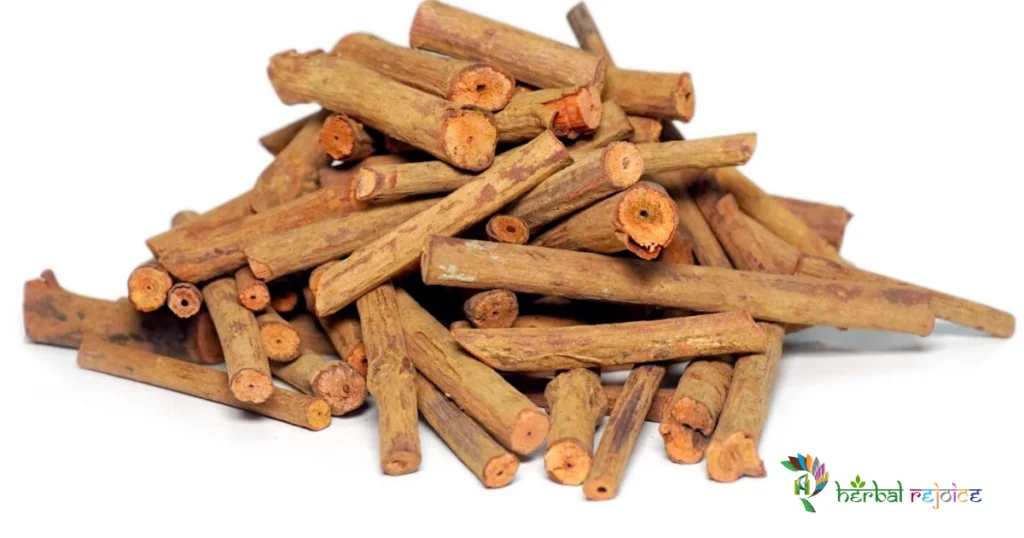Introduction
Manjistha / Indian Madder (Rubia cordifolia Linn.), also known as Bengal Madder, is a medicinal plant found throughout India, ascending to an altitude of 3,700 m. Indian Madder in the treatment of blood, skin, and urinogenital disorders. It is also used for dysentery, piles, ulcers, inflammation, erysipelas, skin diseases, and rheumatism.
Names and Habitat Of Manjistha
In Ayurvedic medicine, it is called Manjishthaa, Vikasaa, Samangaa, Yojanavalli, Kaalameshika, Raktaangi, Raktayashtikaa, Arunaa, Gandira, and Jingi. In Unani medicine, it is known as Manjeeth, and in Siddha/Tamil medicine, it is called Manjitti.
Chemical Constituents Of Manjistha
However, it is important to note that the mutagenic and carcinogenic aspects of Manjistha are currently under investigation. It has been reported that after oral administration of the root decoction, the patient’s urine and bones may show a red tinge.
This is due to the presence of anthraquinones and their glycosides in the roots, including purpurin, munjistin, xanthopurpurin, peudopurpurin, alizarin, and their glucosides.
The whole plant also contains pentacylic triterpenic acids such as rubicoumaric and rubifolic acids.
Key Components and Benefits
Additionally, Manjistha / Indian Madder has been found to contain antitumor cyclic hexapeptides, although lucidin, another compound found in the plant, is thought to be carcinogenic.
The root extracts of a closely related species, R. sikkimensis Kurz, known as Naaga-Madder, have similar medicinal properties to those of R. cordifolia.
Indian Madder has various medicinal properties and is particularly known for its ability to purify the blood.
It is also used as an astringent, diuretic, emmenagogue, deobstruent, antidysenteric, antiseptic, and alterative.

Dosage Of Indian Madder
The recommended dosage of Manjistha stems is 2-4 grams. However, it is important to consult a qualified healthcare practitioner before using this herb for medicinal purposes.
Conclusion
In conclusion, Indian Madder (Rubia cordifolia Linn.) is a highly valued medicinal plant in traditional Indian medicine. Its various therapeutic properties, including its role as a blood purifier, astringent, diuretic, and more, make it a popular choice for the treatment of various ailments.
However, further research is needed to fully understand its potential mutagenic and carcinogenic effects. When used responsibly and under the guidance of a healthcare professional, Indian Madder can be a valuable addition to natural health treatments.
Frequently Asked Questions(FAQs)
What is Manjistha?
Manjistha or Indian Madder, also known as Rubia cordifolia Linn., is a medicinal plant found throughout India with various therapeutic properties.
What are the medicinal properties of Manjistha?
Manjistha is known for its ability to purify blood. It also has astringent, diuretic, emmenagogue, deobstruent, antidysenteric, antiseptic, and alterative properties.
How is Manjistha used in Ayurvedic medicine?
In Ayurvedic medicine, Indian Madder is known as Manjishthaa and is used in the treatment of blood, skin, and urinogenital disorders.
What is the recommended usage of Manjistha stems?
The recommended dosage of Manjistha stems is 2-4 grams.
What are the reported potential side effects of Manjistha?
After oral administration of Manjistha root decoction, the patient’s urine and bones may show a red tinge. This is due to the presence of certain compounds in the plant.
Is Manjistha under investigation for its mutagenic and carcinogenic properties?
Yes, the mutagenic and carcinogenic aspects of Manjistha are currently being investigated.
What compounds are found in Manjistha roots?
Manjistha roots contain anthraquinones and their glycosides, including purpurin, munjistin, xanthopurpurin, peudopurpurin, alizarin, and their glucosides.
Are there any particular acids found in Manjistha?
Manjistha also contains pentacylic triterpenic acids such as rubicoumaric and rubifolic acids.
Are there any antitumor compounds present in Manjishthaa?
Yes, Indian Madder has been found to contain antitumor cyclic hexapeptides.
Is lucidin found in Manjistha?
Yes, lucidin, another compound found in Indian Madder, is thought to be carcinogenic.
What is the traditional medicinal use of the closely related species of Indian Madder?
The closely related species called Naaga-Madder, or R. sikkimensis Kurz, has similar medicinal properties to Indian Madder.
Can Manjistha be used for the treatment of dysentery and ulcers?
Yes, Manjistha is traditionally used for the treatment of dysentery, ulcers, inflammation, erysipelas, skin diseases, and rheumatism.
What is Manjistha called in Unani medicine?
In Unani medicine, Indian Madder is known as Manjeeth.
What is Manjistha called in Siddha/Tamil medicine?
In Siddha/Tamil medicine, Indian Madder is called Manjitti.
Can Manjistha be used for the treatment of urinary disorders?
Manjistha is used in Ayurvedic medicine for the treatment of urinogenital disorders, suggesting its potential benefits for urinary disorders.
Is Manjistha effective for treating piles?
Manjistha is traditionally used for the treatment of piles, indicating its potential effectiveness for this condition.
Does the Ayurvedic Pharmacopoeia of India recommend the use of Manjistha?
Yes, the Ayurvedic Pharmacopoeia of India recommends the use of dried stem of Indian Madder for various disorders.
Is Manjistha a popular choice for natural health treatments?
Yes, Indian Madder is highly valued in traditional Indian medicine and is considered to be a popular choice for natural health treatments.
What further research is needed on Manjistha?
Further research is needed to fully understand the potential mutagenic and carcinogenic effects of Manjistha/ Indian Madder.


